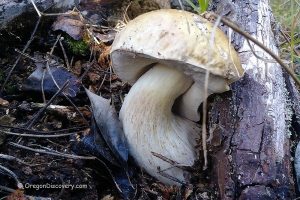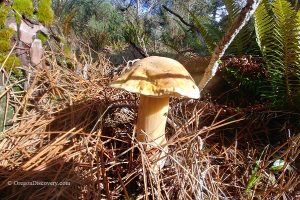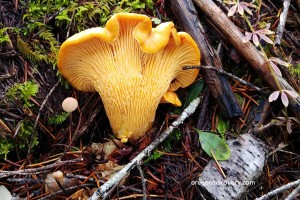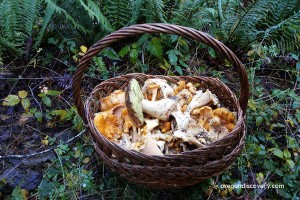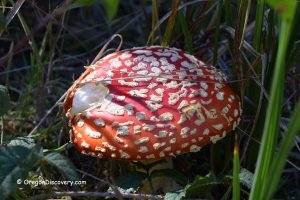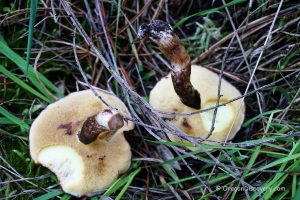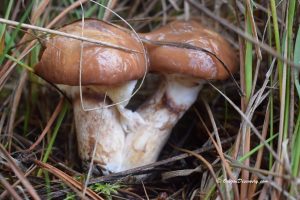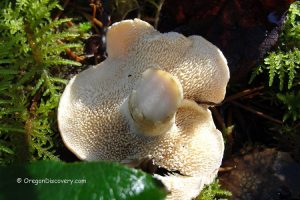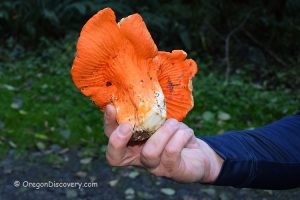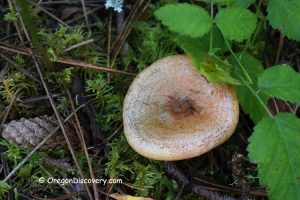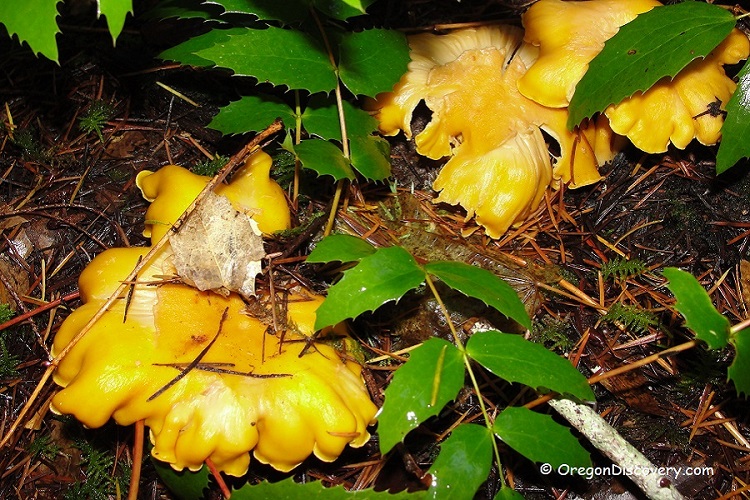
• The most popular species of edible mushrooms all over the world
• Chanterelle has potent insecticidal properties
Cantharellus in Latin means "little drinking cup". One of the most popular species of edible mushrooms all over the world, chanterelle tends to be the most difficult fungi to cultivate. Highly-prized wild-picked chanterelles are exported worldwide. These delicious but expensive mushrooms can be found in supermarkets and farmer stores as well as in the forests nearby for free. These beautifully colored funnel-shaped fungi are abundant in the Pacific Northwest, including Oregon.
Chanterelles are growing throughout the state of Oregon. They can be found on the Cascade Mountains, Coast Range, in the Willamette Valley, and on the Pacific Coast. They are abundant in the Mt. Hood area, Willamette and Umpqua National Forest, Tillamook State Forest, and so on.
The species are mycorrhizal fungi that mean they build symbiotic relationships with the roots of ectomycorrhizal trees and shrubs in the coniferous and deciduous forests and often grow among ferns.
The Chanterelle family, also includes Craterellus, Gomphus, and Polyozellus. All four genera in the family are convex or vase-shaped. All of them bear ridges and veins instead of gills.
Chanterelles of different sizes are fruiting singly or in groups. It is highly recommended to cut them from their base instead of pulling them out to keep the small mushrooms and their base still growing.
Pacific Golden Chanterelle (Excellent Edible)
 The Pacific golden chanterelle (Cantharellus formosus) is easily identifiable and is perfect for novices who are eager to harvest delicious wild mushrooms. These mushrooms have potent insecticidal properties and are generally free of bugs. Besides, this fungi has high nutritional and culinary value.
The Pacific golden chanterelle (Cantharellus formosus) is easily identifiable and is perfect for novices who are eager to harvest delicious wild mushrooms. These mushrooms have potent insecticidal properties and are generally free of bugs. Besides, this fungi has high nutritional and culinary value.
White Chanterelle (Excellent Edible)

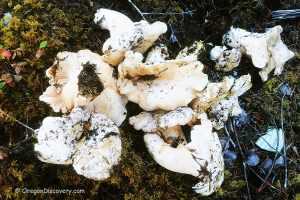

Like the Pacific golden chanterelle, the White chanterelle (Cantharellus subalbidus) is species native to the Pacific Northwest. A species described by Dunham is most likely found in the old-growth coniferous forest (200-1000 years old) at a low elevation from British Columbia to California. The White chanterelle is similar to other chanterelles except for its whitish appearance and orange bruising. It is one of the best edible fungi with a meaty texture and sweet odor.
Cap: Funnel-shaped, center sunken, wavy margins, not round, white to cream, 2-6 inches (5-15 cm) wide.
Cap's Underside: Wrinkles, ridges with interlacing veins, going down the steam, white to cream.
Spore Print: Elliptical and white.
Stem: White to cream. Older species are yellowish. Flesh turns orange when bruised. Descending stalk. 1-3 inches (2-7 cm) long.
Flesh: Firm and solid, white to cream.
Fruiting: Singly, scattered, or in groups.
Habitat: Mycorrhizal with conifer trees: Douglas firs, hemlock, pine, and Pacific madrone. Most likely found in the old-growth coastal forest.
Season: Fall.
Nutrition Facts
The fungi are a source of dietary fiber, protein, potassium, copper, manganese, iron, Vitamins C, D, B, and A. The presence of these compounds ensures the number of health benefits such as immunomodulatory, anti-inflammatory, antioxidant, antiviral, anti-cancer, antimicrobial, and antigenotoxic.
A few studies have suggested that the chanterelles may have potent insecticidal properties that protect the mushroom body against insects and other potentially harmful organisms but are harmless to humans.
How to cook Chanterelles?
Methods of cooking: Stir-frying, sautéing, drying, pickling, preserving, or freezing. Do not eat chanterelles raw. Their cell walls are hard to digest and could cause an upset stomach. Any type of cooking helps break down cell walls, making them easier to digest.
According to many sources, chanterelles should not be washed because they quickly absorb water and become soft. Clean chanterelles gently with a brush. If they are very dirty, you can quickly rinse them, so they do not absorb too much water.
Woolly or Scaly Vase Chanterelle (Inedible)


The Wooly chanterelle (Turbinellus floccosus) is also known as Scaly Vase or Shaggy Chanterelle. The species have the orange to the orange-red wooly, scaly vase-shaped cap. The Wooly chanterelle is edible but not recommended because it contains an indigestible acid that can cause indigestion in some people. Also, some compounds of the species might be harmful to the liver.
Cap: Trumpet-shaped, coarsely scaly on the top, orange-red, 2-6 inches (5-15 cm) wide.
Cap's Underside: Blunt wrinkled funnel-shaped ridges descending down the steam, orange to yellowish.
Spore Print: Elliptical, ochre.
Stem: Thick orange to yellowish. Descending stalk with a shallowly wrinkled surface. 2-4 inches (5-10 cm) long.
Flesh: Fibrous, whitish.
Fruiting: Singly, scattered, or in groups.
Habitat: Mycorrhizal with coniferous or mixed forest.
Season: Mid-summer to mid-fall.
False Look-alikes
Do not confuse chanterelle which has ridges with look-alike gilled inedible bitter False Chanterelles and poisonous Jack O'Lantern (Omphalotus Olearius). Chanterelles grow on the soil under conifer trees or oaks. False Chanterelle prefers decaying conifers. Jack O'Lantern is clustered at the bases of oak, madrone and other deciduous trees. Hence, the yellow mushrooms which resemble chanterelle are very likely false chanterelle or Jack O’Latern.
Chanterelles vs Non-Chanterelle | Important Tips for Identification
This mushroom is not the chanterelle IF:
- Cap is round and flat
- Split mushroom has a hollow stem
- The internal color of its flesh is not white
- Gills are present - gills are separated easily.

False Chanterelle (Inedible)
False Chanterelle (Hygrophoropsis aurantiaca) is reddish (no yellow) with the graded darker center of 1 to 4 inches wide cap. It has hollowed steam and true soft gills forked on the margins.
This mushroom is bitter and indigestible and hardly to be recommended. The false chanterelle is fruiting in troops on litter or rotten logs. Unlike chanterelles, false chanterelles are not mycorrhizal and can be found in areas with no trees.
Jack O'Lantern (Poisonous)
Poisonous Jack O'Lantern (Omphalotus olearius) is bright orange with caps from 2 to 5 inches wide. The mushrooms are fruiting in clusters on decaying trees and stumps. The decurrent gills glow in the dark in low light conditions.
Unlike chanterelles, Jack O'Lantern are not mycorrhizal fungi that mean it can grow where no trees. These mushrooms contain toxin illudin that cause nausea and vomiting associated with abdominal cramp and diarrhea.
You May Also Enjoy
Disclaimer
This is not an official guide to wild mushroom foraging. Please, do your own research, be sure to practice with a mushroom expert before you pick up and consume any wild mushrooms. Before you start wild mushroom harvesting, learn to accurately identify poisonous mushrooms as well. All wild edible mushrooms must be thoroughly cooked. Make sure that you are not allergic to a new mushroom by trying a small amount before eating more.
Dunham, S. M., O’Dell, T.E., and Molina R. 2006. Forest stand age and the occurrence of chanterelle (Cantharellus) species in Oregon’s central Cascade Mountains. Mycological Research 110 (2006); 1433-1440.
Cantharellus Cibarius - Culinary-Medicinal Mushroom Content and Biological Activity. https://www.ncbi.nlm.nih.gov
Cieniecka-Rosłonkiewicz A, Sas A, Przybysz E, Morytz B, Syguda A, Pernak J. "Ionic liquids for the production of insecticidal and microbicidal extracts of the fungus Cantharellus cibarius". 2007. Chemistry & Biodiversity.

